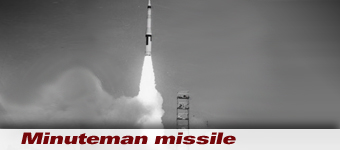First Minuteman Launched from a Silo

On Nov. 17, 1961, the U.S.Air Force launched the first Minuteman missile from an underground silo at Cape Canaveral, Fla., on a 3,000-mile flight down the Atlantic Missile Range. The Minuteman I (LGM-30A/B) is a three-stage, solid-propellant, rocket-powered ICBM with an all-inertial guidance system and has the capability of being fired from hardened and widely-dispersed underground-silo launchers.
In the late 1950s the Air Force developed its first solid-fuel ICBM, the Minuteman I. The Air Force put its first ten Minuteman ICBMs on operational alert at Malmstrom AFB, Mont., in October 1962 and within five years 1,000 of the solid-fuel missiles stood poised in their silos.
By the spring of 1957, Air Force research indicated that a solid-fuel ICBM was possible, and by that fall the Air Force Ballistic Missile Division had designed the revolutionary Minuteman ICBM. In marked contrast to the first generation Atlas and Titan I liquid-fuel missiles, the designer proposed building a relatively small, three-stage solid-fuel missile that would be inexpensive to build and maintain. The vison was to base thousands of the missiles in unmanned, heavily hardened and widely dispersed silos linked electronically to a series of central launch control facilities where it would be virtually immune from an enemy nuclear attack.
In September 1959 the AFBMD successfully launched a Minuteman first stage motor directly from an underground silo, thus proving that the missile would survive the rigors of a subsurface launch. In February 1961 the AFBMD launched a Minuteman containing all three stages and operational subsystems from the Air Force Missile Test Center in Florida. This was called an "all up" test. The missile performed and after a flight of 4,600 miles its reentry vehicle landed within the designated impact zone.
Based on the success of the initial test flight, in March 1961 the Department of Defense formally accelerated the Minuteman program and gave it the same development priority as the Atlas and Titan ICBM programs.
Minuteman II, first launched in 1964, was capable of striking from six to eight targets with far greater accuracy than its predecessor. The next version, Minuteman III, was first launched in 1968, with more accuracy, range and target capability. By 1975, the 1,000 Minuteman U.S. missiles were either Minuteman IIs or IIIs.
A consortium of five contractors produced four distinct models of the Minuteman ICBM weapon system, each model being an improvement over the former: Minuteman I (models "A" and "B"), Minuteman II (model "F"), and Minuteman III (model "G"), which was capable of carrying multiple independently-targetable reentry vehicles.